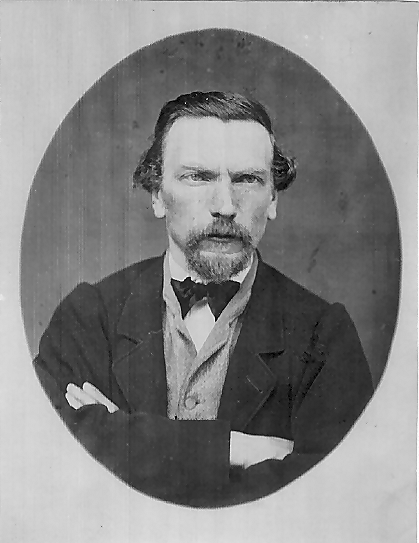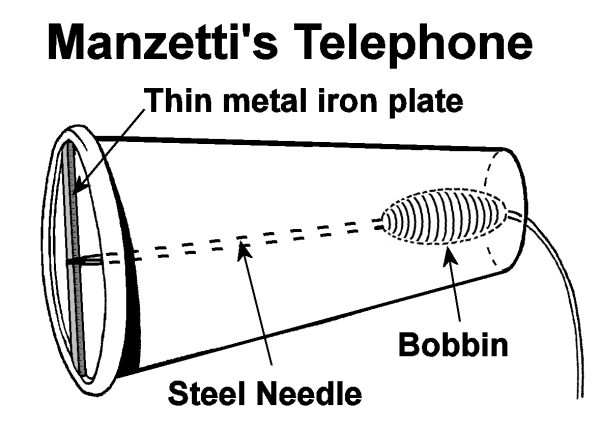Who Really Invented the Telephone? Part 2 - Innocenzo Manzetti (1826-1877)
More Previous Columns
January 15, 2011
Who Really Invented the Telephone? Part 2 — Innocenzo Manzetti (1826-1877)
 In the days ahead we will examine in succession a several people, each of whom performed an important role in the birth of the telephone. After an introduction to the series, the first person we examined was German inventor, Johann Philipp Reis. See: Who Really Invented the Telephone? Part 1 — Johann Philipp Reis (1834–1874)
In the days ahead we will examine in succession a several people, each of whom performed an important role in the birth of the telephone. After an introduction to the series, the first person we examined was German inventor, Johann Philipp Reis. See: Who Really Invented the Telephone? Part 1 — Johann Philipp Reis (1834–1874)
Next in this series is the gifted Italian inventor, Innocenzo Vincenzo Bartolomeo Luigi Carlo Manzetti (17 March 1826 – 17 March 1877).
Figure 3. Innocenzo Manzetti (at right) independently devised an imperfect, inefficient telephonic system similar to that of Johann Philipp Reis, but he appears to have conceptualized electrical telephony as early as 1844.
Born in the town of Aosta, Italy on March 17, 1826, he was educated as a land surveyor but became interested in acoustics, mechanics, hydraulics, electricity and astronomy. Legend has it that he slept but two hours a day and worked and experimented constantly during his waking hours.
A mechanical genius, he first gained fame in 1849 with a flute-playing automaton controlled by a player piano-like mechanism consisting of a program recorded on a cylinder. He ultimately modified the device so that one could play it at a distance from an organ keyboard. The idea for a telephone allegedly came to Manzetti when he asked himself why he couldn’t also make his automaton pronounce words he spoke remotely.
Manzetti, who was fluent in both Italian and French, called his first (1864) telephone model the télégraphe parlant or “speaking telegraph.”
Although it appears that Manzetti came up with the idea for a telephone-like device in 1844, and although a number of newspapers of the time discussed the invention, the only surviving technical description of Manzetti’s device was one written in French by his friend Dr. Pierre Dupont, a medical doctor and Major in the Sardinian army. He describes a funnel-shaped cornet into which was placed a very thin transverse-mounted iron plate. Sound waves entering the bottom of the funnel vibrated the plate. Almost touching the plate was a perpendicular magnetized steel needle, running inside a bobbin or coil. Silk-coated copper wires stretched from this bobbin to another one in an identical apparatus. The vibrations of the iron plate in front of a pole of a piece of magnetized iron produced the same kind of “make and break” electric currents found in Johann Philipp Reis’ 1861 telephon, which were transferred to the coil in the receiver and pushed the coil against the metal plate, thus roughly reproducing the acoustic waves via magnetostriction.
The August 22, 1865 edition of La Feuille d'Aoste had reported: “It was also rumoured that English technicians to whom Manzetti illustrated his method for transmitting spoken words on the telegraph wire intended to apply the invention on several private telegraph lines in England.” However, there is no evidence that anyone in the U.K. had Manzetti-like 'speaking telegraphs' operating in the U.K. at that time. The first telephone to enter the United Kingdom was one brought by Alexander Graham Bell in 1877, used in a demonstration for Queen Victoria. Even Bell did not have a working model of a telephone until March 1876.
In an article appearing in the November 22, 1865 edition of the Parisian newspaper, Le Petit Journal, itself extracted from a similar article in the Sardinia Courier ("Il Corriere di Sardegna"), Emile Quetand of the Parisian court wrote the following:
A discovery which will produce universal results in its applications to the arts and industries, has recently been added to the numerous wonders of the century; it is the transmission of the sounds of the voice by telegraph. The author of the invention… who is also the inventor of a celebrated automaton, transmits words with the ordinary telegraph wire, and with an apparatus more simple than that which at present serves for dispatches. Henceforth two merchants may communicate instantly their business affairs between London to Calcutta, announce each other’s speculations, agreements, etc. Some successful experiments have been made, which confirm the practical possibilities of the invention. It also transmits musical notes; as for the words, the sonorous ones are heard distinctly… At Aosta a monument has been erected, with the following inscription: ‘Inncenzo Manzetti, inventor and maker, in the year 1864, of the first telephonic apparatus.’
Unfortunately, Manzetti’s telephone, like that of Reis, shared the fundamental problem common to all “make and break” systems—while vowels and tones could be transmitted faithfully, but consonants and fully articulated words could not. Indeed, in newspaper articles of the time, Manzetti was said to be having difficulty eliminating this problem. A friend of Manzetti’s, a clergyman named Edouard Bérard, was quoted as saying that words containing the letters c, f, g, j, l, u, v, x, and z could not be transmitted, which made it impossible to hold a complete conversation.

Figure 4. This drawing of Manzetti’s telephone (at left) is based on the notes of his friend Dr. Pierre Dupont. The notes date from perhaps as early as 1861 but certainly not later than 1865.
Like Reis, Manzetti apparently never solved the difficulties inherent in this type of telephonic system. It was never patented or demonstrated at any scientific conferences. After a brief flurry of newspaper articles about Manzetti and the exciting commercial possibilities of his télégraph parlant, no further word of it appears in the press from 1865 on.
From all accounts, Manzetti appears to have been an extraordinarily gifted inventor. In 1855 Manzetti devised a hydraulic pump-like mechanism to remove water from the previously unworkable Ollomont copper mines of the Aosta Valley in Italy that had been in use since 1600 (and, with the help of Manzetti's and other similar technology, remained in use until 1945). In 1864 he built a steam-powered car. The world would not see another one for 27 years, when Léon Serpollet built and demonstrated one in Paris.
He also built a wooden flying parrot toy for his daughter that could hover for two or three minutes before settling down again. Other Manzetti innovations include geodetic instruments he used when working as a surveyor, a bicyclem a piano, a type of pantograph capable of reproducing bas-reliefs on ivory, marble or wood, a telescope with three converging lenses that in a demonstration allowed one user to observe the movement of a small lizard at a distance of more than 4 miles (7 km). Manzetti even devised a pendulum watch capable of running for a year on a single winding.
Manzetti, however, was a humble man who lacked business ambitions or acumen. He died impoverished in Aosta on his 51st birthday, March 17, 1877, just one year after the death of his second (and last) daughter, Marina Fortunata. (His first daughter, Maria Sofia, died in 1867, at age two.) •
